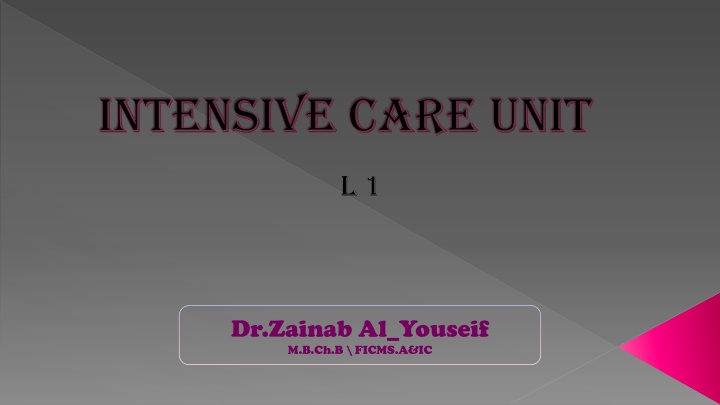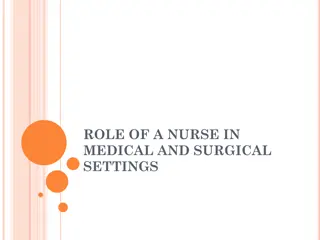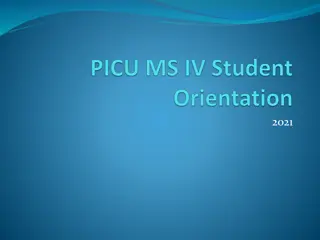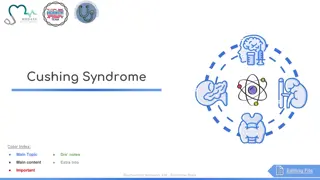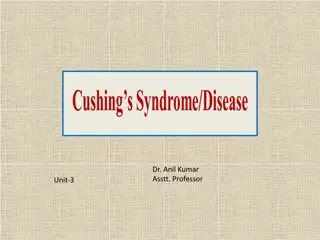Evolution of Intensive Care Units: From Harvey Cushing to Modern Healthcare
Intensive care units (ICUs) have evolved through the meticulous practices of pioneers like Harvey Cushing, who emphasized post-operative care and infection control. As surgical procedures advanced, ICUs became crucial in saving lives during critical medical conditions. From reducing mortality rates to introducing modern technologies, this narrative sheds light on the origins and importance of ICU care.
Download Presentation

Please find below an Image/Link to download the presentation.
The content on the website is provided AS IS for your information and personal use only. It may not be sold, licensed, or shared on other websites without obtaining consent from the author.If you encounter any issues during the download, it is possible that the publisher has removed the file from their server.
You are allowed to download the files provided on this website for personal or commercial use, subject to the condition that they are used lawfully. All files are the property of their respective owners.
The content on the website is provided AS IS for your information and personal use only. It may not be sold, licensed, or shared on other websites without obtaining consent from the author.
E N D
Presentation Transcript
Intensive care unit L L 1 1 Dr.Zainab Al_Youseif M.B.Ch.B \ FICMS.A&IC
Intensive care unit Intensive care unit An intensive care unit (ICU), also known as an intensive therapy unit or intensive treatment unit (ITU) or critical care unit (CCU), is a special department of a hospital or health care facility that provides intensive care medicine.
How intensive care units were born? Harvey Cushing was the most brilliant brain surgeon of his generation. His patients adored him, describing him as caring and kind, but he kept his staff in a perpetual state of terror. He was intolerant of mistakes and could be cold, harsh and bullying. But he was forgiven, because his results spoke for themselves. Before Cushing, eight out of 10 brain surgery patients died. In his hospital, the surgeon reduced mortality to just 8%. In a time before antibiotics, and the ever-present risk of bacterial infection killing anyone going under the knife, Cushing operated under the strictest cleanliness. He wore gloves and a mask, doing whatever he could to sterilise the wound and reduce the chance of disease. Crucially, Cushing continued the care after he had finished his operations the period when patients were at greatest risk of dying.
How intensive care units were born? How intensive care units were born? Cushing carried over his meticulousness during surgery to the post-operative care of the patients He often tended to patients wounds himself, ensuring they were kept free of infection. He introduced strict observation systems and record keeping and the first widespread use of x-rays and blood pressure monitoring. Each individual patient was the focus of care by a team of specialist staff. Cushing's whole ward was more like an intensive care unit than other surgeons, Spencer explains. The nurses and junior surgical staff knew that if the bed sheets were not tucked in properly, the dressing wasn't clean or the patient was complaining, they were going to be in big trouble.
How intensive care units were born? How intensive care units were born? As operations became more complex through World War Two and into the 1950s with, for example, the first open heart surgery Cushing s pioneering post-operative care became widespread, saving countless lives In August 1952, the Blegdam Hospital in the Danish capital Copenhagen was overwhelmed by hundreds of seriously ill polio patients. Without assistance to help them breathe, most would die. The only treatment available was a mechanical respirator system, known as an iron lung.
The polio epidemic in Copenhagen resulted in 316 patients developing respiratory muscle paralysis and/or bulbar palsy, with subsequent respiratory failure and pooling of secretions. The Blegham Hospital, the hospital in Copenhagen for communicable diseases, had only one tank respirator and six cuirass respirators at the time. This was completely inadequate to support the hundreds of polio patients with respiratory failure and bulbar palsy. The mortality rate from polio with respiratory failure and historically 85 90% and, as the epidemic progressed, the situation looked desperate. bulbar involvement was
Professor Lassen, chief physician at the Blegdam Hospital, had a strong desire to provide treatment for all polio victims, despite insufficient respirators, and therefore consulted with Dr Bjorn Ibsen, a Copenhagen anaesthetist. Professor Lassen hoped that positive pressure ventilation, as used in modern anaesthesia at that time, might be a solution.1 Two days later, a 12-year-old girl with polio and resultant respiratory failure and bulbar palsy had a tracheostomy formed just below the larynx: a rubber cuffed tracheostomy tube was inserted and positive pressure ventilation successfully delivered manually with a rubber bag. Tracheostomies had been performed in Copenhagen for 4 years before this, but with little beneficial effect on outcome. Dr Ibsen had the idea of caring for all such patients in a dedicated ward, where each patient could have their own nurse. Thus, in December 1953, the specialty of intensive care was born
Intensive care has undergone enormous change since the establishment of the specialty more than 65 years ago, and further changes undoubtedly be coming years. will in seen
intensive care medicine intensive care medicine Intensive care medicine, also called critical care medicine, is a medical specialty that deals with seriously or critically ill patients who have, are at risk of, or are recovering from conditions that may be life-threatening. It includes providing life support, invasive monitoring techniques, resuscitation, and end-of-life care. Patients may be referred directly from an emergency department or from a ward if they rapidly deteriorate, or immediately after surgery if the surgery is very invasive and the patient is at high risk of complications.
Most Common Type Of ICU Most Common Type Of ICU Neonatal intensive care unit (NICU). Pediatric intensive care unit (PICU). Coronary care unit (CCU) Neurological Intensive Care Unit (NeuroICU). Post-anesthesia care unit (PACU) High dependency unit (HDU)
Neonatal intensive care Neonatal intensive care unit unit (NICU) (NICU) This specialty unit cares for neonatal patients who have not left the hospital after birth. Common conditions cared for include prematurity and associated complications, congenital disorders such as congenital diaphragmatic hernia, or complications resulting from the birthing process.
Pediatric intensive care unit Pediatric intensive care unit (PICU) (PICU) Pediatric patients are treated in this intensive care unit for life-threatening conditions such as asthma, influenza, diabetic ketoacidosis, or traumatic neurological injury.
Coronary care unit Coronary care unit (CCU) (CCU) Also known as Cardiac Intensive Care Units (CICU) or Cardiovascular Intensive Care Unit (CVICU), this ICU caters to patients specifically with congenital heart defects or life-threatening cardiac conditions such as a myocardial infarction or a cardiac arrest.
Neurological Intensive Care Neurological Intensive Care Unit ( Unit (NeuroICU NeuroICU) ) Patients are treated for brain aneurysms, brain tumors, stroke, and post surgical patients who have undergone various neurological surgeries performed by experienced neurosurgeons require constant neurological exams. Nurses who work within these units have neurological certifications.
Post-anesthesia care unit (PACU) Also known as the post-operative recovery unit, or recovery room, the PACU provides immediate post-op observation and stabilization of patients following surgical operations and anesthesia
High dependency unit (HDU) most acute hospitals have a transitional high dependency unit (HDU) for patients who require close observation, treatment and nursing care that cannot be provided in a general ward, but whose care is not at a critical stage to warrant an (ICU) bed
